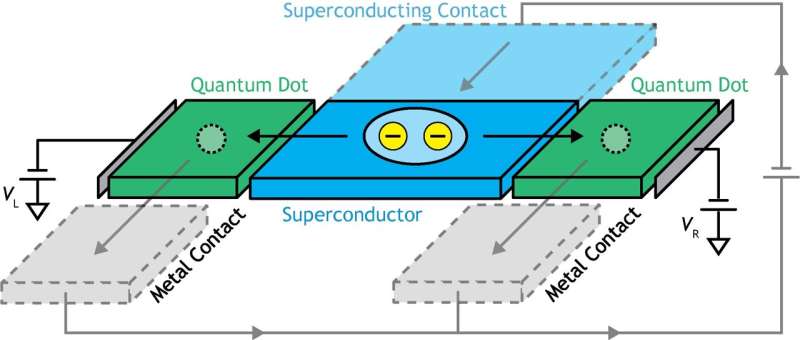Controlling the division of a single Cooper pair in a hybrid quantum dot system

The date is November 6, 2023
This article has undergone rigorous assessment as per Science X editorial guidelines and stringent policies. Certain key elements were critically evaluated to ensure the credibility of the content:
- The article was fact-checked
- Peer-reviewed before publication
- Trusted sources were utilized
- The article has been proofread
Article by Ingrid Fadelli, Phys.org
In the field of superconducting materials, Cooper pairs refer to pairs of electrons that connect at low temperatures, forming the basis of superconductivity. Superconductivity is a condition where materials, devoid of resistance at low temperatures due to quantum effects. Superconductors, being quantum systems that can be significantly large and easy to control, play a critical role in the evolution of quantum computers and other sophisticated technologies.
Researchers at Delft University of Technology (TU Delft) recently showcased the controllable separation of a Copper pair into its fundamental electrons within a hybrid quantum dot system, while maintaining them after the separation. Their research, documented in Physical Review Letters, might lead to new directions for scrutinizing superconductivity and entanglement within quantum dot systems.
Christian Prosko, one of the contributors to the study, stated to Phys.org that the study was driven by the notion that Cooper pairs, the quintessential elements of superconductivity that carry electrical current without resistance, are produced by pairs of electrons anticipated to be perfectly quantum entangled.
He explained that several research groups have focused efforts on separating Cooper pairs into their two fundamental electrons to inspect this entanglement. Their aim was to build on this by creating a device that could retain two electrons post-separation from a pair to further probe their attributes.
The TU Delft lab, run by Leo P. Kouwenhoven, is known for applying techniques that use microwave resonators to track the movement of electrons, thus controlling electrons in devices without the need for passing electrical currents through them. It adds significant momentum to efforts of checking if two particles are quantum entangled.
Prosko added that they were successful in retaining them within quantum dots, areas of semiconducting material meant to act like containers to hold electrons.
Apart from this, they were keen on exhibiting a method for detecting the moment a Cooper pair separates. As such, they fabricated a detector from quantum dots that can perceive when an individual electron jumps on or off it. Simultaneously, another group also recorded the separation of single Cooper pairs.
Typically, orthodox devices that split electrons, bound in Cooper pairs, are composed of a superconductor-based electrical contact and two average metallic contacts that are separated by quantum dots. Globaluronicsels only receive one electron at a time, while the electrical current that goes through semiconductors is ferryied by electron Cooper pairs.
Prosko further explained that they replaced the supersconducting lead with an isolated chunk of superconductor and eliminated the electrical contacts entirely. They were able to 'push' a single Cooper pair out of the superconductor by applying electric fields to the quantum dots and superconductor, compelling it to separate onto the two quantum dots.
The unique design of their hybrid quantum dot system, bereft of electrical contacts, prevents any electrical current from flowing through it. Once they 'pushed' a single Cooper pair from the superconductor, the electrons got isolated onto the quantum dots. This allowed them to retain split electrons that were originally part of a single Cooper pair.
According to Prosko, their recent work mainly consisted of two components: separating a single Cooper pair and retaining the resulting electrons, and separately showcasing a method for detecting single electrons jumping on to a quantum dot without external charge sensors.
He said. 'These two developments collectively enabled us to initiate Cooper pair splitting events and detect the resultant electrons in real time, taking us a step closer towards examining the quantum entanglement of electrons, which is so crucial to superconductivity.'
Some of the authors of this paper have now completed their Ph.D. at TU Delft and started working at other institutes and companies. In the future, these researchers and other students who are still part Kouwenhoven's lab will continue exploring superconductivity, quantum entanglement, and quantum computing.
'We hope our research groups will continue combining the single Cooper pair splitting technique with parity sensors that can also detect the magnetic spin of electrons,' Prosko added.
'This would allow for a test of Bell's inequality, where we could verify that electrons in superconductors really are quantum entangled. Similar tests have been carried out on electrons in semiconducting qubits. On another note, our research group has been very interested in Cooper pair splitters recently as a way to build especially robust qubits out of exotic so-called 'Majorana bound states', and these qubits might be more effective by using our approach of getting rid of some of the lead contacts.'
Journal information: Physical Review Letters
© 2023 Science X Network




